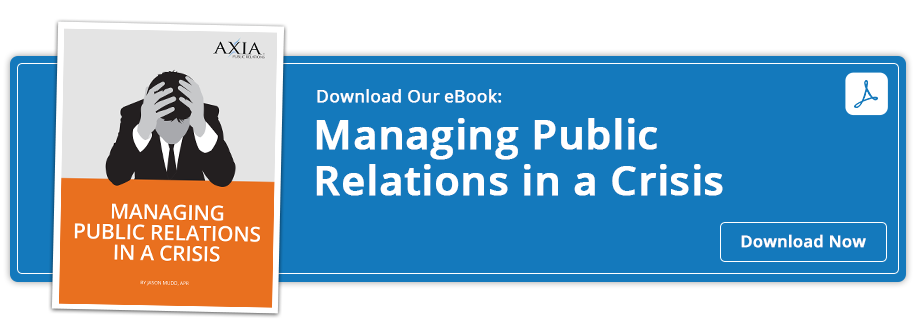By Jason Mudd, APR
One key phrase oft repeated inside newsrooms is “If it bleeds, it leads.”
To those outside the communications profession, that may sound utterly offensive, but realistically, news editors, writers, journalists and programming directors know that when it comes to news, people listen and watch more intently when it’s negative. In fact, bad news far outweighs good news by as much as 17 negative news stories for every one positive one. Scholars have studied the psychology behind this, too. The human brain evolved in a hunter-gatherer environment where dramatic events required immediate attention for the sake of survival, and we still care (worry/fear) more about the threat of bad things affecting us than hearing about good things. When the news is negative, people take notice.
The first reaction to negative scrutiny for most businesses (or even people) is often silence or denial. No business wants to share news of a missed sales forecast that will adversely impact its stock any more than it would want to openly discuss a product contamination. It’s bad for business … period. So what is a business to do if it (a) has a responsibility to report the negative truth or (b) finds itself hounded by media in pursuit of a negative story?
Steer clear of “No comment.”
When a friend asks, “How’s your day?” do you reply, “No comment?” Of course not. “No comment” is simply never a good answer. In fact, the team at Axia Public Relations invests heavily in training clients to avoid using this go-to catchphrase which simply means, “I am choosing not to answer your questions.”
When you don’t answer, reporters will use keen research abilities and near limitless resources to derive answers all on their own – with or without your permission. Instead, when put into a position to deliver negative news, do it truthfully, do it fast and prepare to respond and inform to avoid communication pitfalls.
Question: “Mr. CEO, is it true that you will be closing the doors to 10 of your stores in the next month?”
Response: “Unfortunately – and I’m incredibly disappointed to confirm it – we are, in fact, closing the doors to several of our stores. While the number of stores has yet to be determined, there will be store closings. At the same time, we have plans to reabsorb current employees within other operating store locations in the hopes of minimizing layoffs.”
Remember when you were young and your parents chased you to take a nasty-tasting medicine that was so gross it made you gag? You couldn’t imagine how something that tasted so bad could make you feel better. The same is true when it comes to delivering bad news. No one wants to do it, nor does anyone wish to place himself under that kind of scrutiny and doubt. But, as you also may have learned by taking that medicine as a child, doing it quickly is much better than dragging out the process. Disseminating less-than-stellar performance results, news of layoffs or even litigation concerns is never easy, but from a PR and journalism standpoint: Get it over with – quickly. Rip off the bandage with one quick pull, and the pain it brings will end sooner.
Honesty really is the best policy.
Beyond responding quickly, businesses must also respond truthfully. Should you feel the urge to get crafty with the details or temper the truth, think again. Lies beget lies, and getting caught in one will tank you and your business’ credibility. It’s extremely difficult to rebound from a public error in judgment.
The upside to delivering bad news is that if done quickly and truthfully, you can also make sure it’s done in a way you approve. Busy reporters (and your key audiences) will typically avoid straying from a scripted statement if given one. Preparing the negative news alongside a plan in response allows you to frame the information with proper context – often softening what can feel like a severe blow. This also builds credibility, as people will trust that you’re providing information rather than hiding it from them. To further enhance credibility, inform your audiences about your plans or next steps.
Finding yourself in a situation to deliver or respond to negative news can feel incredibly stressful, yet to ease the process, the solution is simple: Do it fast, do it honestly and be prepared to respond and inform. For additional recommendations on how to properly deliver bad news, download Axia Public Relations’ e-book Managing Public Relations in a Crisis.
 – Jason Mudd, APR, is CEO of Axia Public Relations. He is an Emmy Award-winning accredited public relations practitioner, speaker, author and entrepreneur. His public relations portfolio includes work for established national and emerging brands such as American Airlines, Budweiser, Dave & Buster’s, Brightway, Florida Blue, H&R Block, Hilton, HP, Miller Lite, New York Life, Pizza Hut, Ray Charles, Southern Comfort, Verizon and more. Connect with Jason on Twitter @jasonmudd9 and Axia Public Relations @axiapr. Be sure to tweet and share your thoughts below. We’ll read and respond to each of them.
– Jason Mudd, APR, is CEO of Axia Public Relations. He is an Emmy Award-winning accredited public relations practitioner, speaker, author and entrepreneur. His public relations portfolio includes work for established national and emerging brands such as American Airlines, Budweiser, Dave & Buster’s, Brightway, Florida Blue, H&R Block, Hilton, HP, Miller Lite, New York Life, Pizza Hut, Ray Charles, Southern Comfort, Verizon and more. Connect with Jason on Twitter @jasonmudd9 and Axia Public Relations @axiapr. Be sure to tweet and share your thoughts below. We’ll read and respond to each of them.
Topics: public relations, crisis communications


Comment on This Article